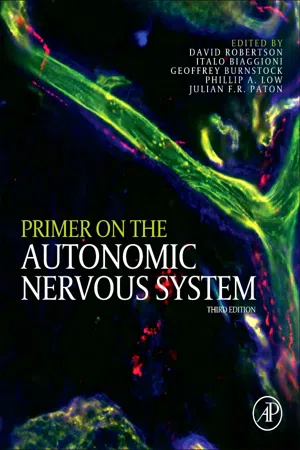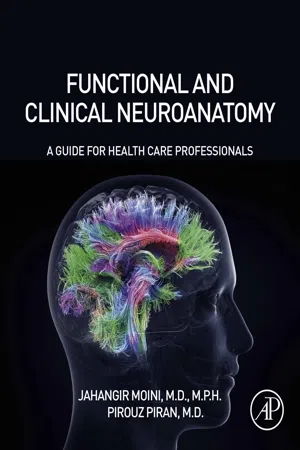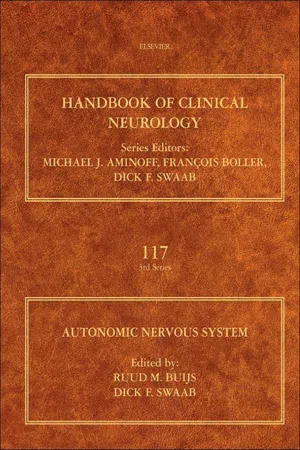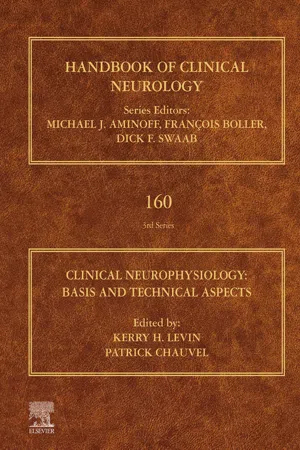Autonomic Nervous System
The autonomic nervous system is a division of the peripheral nervous system that regulates involuntary bodily functions, such as heart rate, digestion, and respiratory rate. It consists of two main branches: the sympathetic nervous system, which prepares the body for action, and the parasympathetic nervous system, which helps the body rest and digest. These two branches work in opposition to maintain homeostasis in the body.
8 Key excerpts on "Autonomic Nervous System"
- eBook - ePub
The Physiological Basis of Behaviour
Neural and Hormonal Processes
- Kevin Silber(Author)
- 2005(Publication Date)
- Routledge(Publisher)
...4 The Autonomic Nervous System Introduction The Autonomic Nervous System (ANS) is a branch of the nervous system which is concerned with regulating the internal state of the organism. The main reason for considering it within a psychology text is because it plays an important role in the control of emotional behaviours. For example, it has a major role in the ‘fight or flight’ response that occurs when we are faced with a dangerous situation. Structure of the ANS Sympathetic and parasympathetic branches The ANS serves many of the internal organs of our body. It is composed of two subsystems, the sympathetic nervous system and the parasympathetic nervous system. These two branches work in a complementary way to regulate the balance of the internal environment. For example, activity in the sympathetic nervous system serves to increase the heart rate, whereas activity in the parasympathetic nervous system serves to reduce the heart rate. Table 4.1 shows some of the organs affected by the ANS and the respective actions of the two branches. Note that not all organs are innervated by both branches of the ANS. For example, the adrenal glands are only innervated by the sympathetic nervous system. First we need to consider briefly the anatomy of the ANS and then look at the brain areas that control it. Anatomy of the ANS Both branches of the ANS send out efferent neurons which travel from the brain along the spinal cord. At various points along the spinal cord fibres branch off to innervate the organs listed in Table 4.1. However, the two systems differ in their structure after the fibres leave the spinal cord. For the sympathetic nervous system, groups of fibres travel only a short way from the spinal cord and then make synaptic connections with ganglia. (A ganglion is a collection of cell bodies of neurons densely packed into a small area.) The ganglia then send out other efferent neurons to innervate the various organs in that region...
- eBook - ePub
- Phillip A. Low(Author)
- 2011(Publication Date)
- Academic Press(Publisher)
...Chapter 4. Peripheral Autonomic Nervous System Robert W. Hamill, Robert E. Shapiro and Margaret A. Vizzard The Autonomic Nervous System (ANS) is structurally and functionally positioned to interface between the internal and external milieu, coordinating bodily functions to ensure homeostasis (cardiovascular and respiratory control, thermal regulation, gastrointestinal motility, urinary and bowel excretory functions, reproduction, and metabolic and endocrine physiology), and adaptive responses to stress (flight or fight response). Thus, the ANS has the daunting task of ensuring the survival as well as the procreation of the species. These complex roles require complex responses, and depend upon the integration of behavioral and physiological responses that are coordinated centrally and peripherally. The Autonomic Nervous System (ANS) is structurally and functionally positioned to interface between the internal and external milieu, coordinating bodily functions to ensure homeostasis (cardiovascular and respiratory control, thermal regulation, gastrointestinal motility, urinary and bowel excretory functions, reproduction, and metabolic and endocrine physiology), and adaptive responses to stress (flight or fight response). Thus, the ANS has the daunting task of ensuring the survival as well as the procreation of the species. These complex roles require complex responses, and depend upon the integration of behavioral and physiological responses that are coordinated centrally and peripherally. In 1898, Langley, a Cambridge University physiologist coined the term “Autonomic Nervous System” and identified three separate components (sympathetic, parasympathetic, and enteric). The following section of the Primer will focus on the first two aspects of the peripheral ANS: sympathetic nervous system (SNS) including the adrenal medulla; and parasympathetic nervous system (PNS)...
- eBook - ePub
Functional and Clinical Neuroanatomy
A Guide for Health Care Professionals
- Jahangir Moini, Pirouz Piran(Authors)
- 2020(Publication Date)
- Academic Press(Publisher)
...Chapter 17 Autonomic Nervous System Abstract The Autonomic Nervous System (ANS) is the visceral part of the human nervous system. It has neurons in both the central nervous system (CNS) and peripheral nervous system (PNS). Its target tissues include the cardiac muscle, smooth muscle of the viscera and blood vessels, and the body's glands. The ANS functions to maintain homeostasis, a constant internal environment. Since it controls involuntary effectors, the ANS is considered to be the subconscious regulator of body functions under normal circumstances. To do this, the ANS uses efferent and afferent pathways, along with various neurons of the brain and spinal cord. The ANS allows us to interact with our environment. For example, if you see a lion in a jungle, your heart rate increases immediately, making it possible for you to run away. Portions of the CNS that participate with the ANS include the nuclei for the cranial nerves III, VII, X, and IX as well as the ventrolateral medulla, anterior cingulate gyrus, insula, amygdala, and hypothalamus. The PNS includes some parts of the ANS, which are basically the parasympathetic and sympathetic nerves. An example is the vagus nerve (CN X). Keywords ANS; Sympathetic division; Celiac ganglia; Craniosacral; CN X The Autonomic Nervous System (ANS) is the visceral part of the human nervous system. It has neurons in both the central nervous system (CNS) and peripheral nervous system (PNS). Its target tissues include the cardiac muscle, smooth muscle of the viscera and blood vessels, and the body's glands. The ANS functions to maintain homeostasis, a constant internal environment. Since it controls involuntary effectors, the ANS is considered to be the subconscious regulator of body functions under normal circumstances. To do this, the ANS uses efferent and afferent pathways, along with various neurons of the brain and spinal cord (Fig. 17.1). The ANS allows us to interact with our environment...
- eBook - ePub
- Ruud M. Buijs, Dick F. Swaab(Authors)
- 2013(Publication Date)
- Elsevier(Publisher)
...Chapter 1 The Autonomic Nervous System a balancing act Ruud M. Buijs *, Department of Cell Biology and Physiology, Institute for Biomedical Research, Universidad Nacional Autónoma de México, Mexico City, Mexico, * Correspondence to: Ruud M. Buijs, Department of Cell Biology and Physiology, Institute for Biomedical Research, Universidad Nacional Autónoma de México, Av. Universidad 3000, Mexico City, DF, 04510, Mexico. E-mail: [email protected] Abstract The overarching theme of the present chapter is the importance of the interaction between brain and body in order to maintain homeostasis – an interaction, rather than a mere top-down or reflex regulation, as signals from the organs may influence the functioning of the brain. For example, the reflex regulation of blood pressure and heart rate is not only subject to modulation by ascending information from the body, but also by descending information from several areas in hypothalamus and cortex. The central nervous system (CNS) has the capacity to control its output via the Autonomic Nervous System (ANS) using an amazing differentiation. For example, not only do the biological clock and prefrontal cortex contain neurons which influence the parasympathetic or sympathetic motor neurons, they also contain different neurons that project to diverse body compartments. In the end this leads to integrated responses whereby visceral sensory information reaches higher centers in the CNS via vagal or spinal sensory pathways, causing a reaction which takes into account factors such as the time of day, the season, the reproductive status, mood. Based on all this information, the brain sets the balance of the different parts of the ANS, causing its output to change its emphasis according to the situation...
- eBook - ePub
Neurology E-Book
An Illustrated Colour Text
- Geraint Fuller, Mark R. Manford(Authors)
- 2011(Publication Date)
- Churchill Livingstone(Publisher)
...The Autonomic Nervous System Anatomy and physiology The Autonomic Nervous System controls important functions that are not under voluntary control, that is autonomous. The extent of this autonomy varies; initiation of swallowing or micturition is voluntary and subsequent execution is automatic, but there is no voluntary component to gastrointestinal motility. As well as descending control from the CNS, some autonomic structures may function independently, and under humoral control. For example, the heart has an intrinsic pacemaker in the sinoatrial node, which may be modulated by circulating adrenaline (epinephrine) and by sympathetic and parasympathetic nerve inputs. CNS control of autonomic function CNS structures that are especially important in the control of the Autonomic Nervous System are in the hypothalamus and the brain stem. The output from the Autonomic Nervous System is in two main parts: sympathetic (SNS) and parasympathetic (PSNS). In addition, the gut contains a local enteric nervous system, which is largely separate. The predominant actions of the SNS are to facilitate functions required for the ‘fight or flight’ response and to inhibit other actions. The PSNS tends to have the opposite functions: ‘rest and digest’. In addition, there are afferent fibres, carrying sensory information regarding the state of the viscera. Sympathetic nervous system SNS fibres descend in the brain stem and lateral columns of the spinal cord. They emerge at each spinal level from T1 to L3 to synapse in ganglia, which form a chain close to the spinal column on either side. The preganglionic neurotransmitter is acetylcholine (nicotinic) and the postganglionic neurotransmitter (at effector organs) is noradrenaline (norepinephrine), except at sweat glands (muscarinic acetylcholine). Parasympathetic nervous system Preganglionic fibres arise from specific nuclei in the brain stem and base of the spinal cord and pass in discrete nerves to ganglia close to the effector organs...
- eBook - ePub
Clinical Neurophysiology: Basis and Technical Aspects
Handbook of Clinical Neurology Series
- (Author)
- 2019(Publication Date)
- Elsevier(Publisher)
...Section VII Autonomic Nervous System: Basic and technical aspects Chapter 27 Basics of Autonomic Nervous System function Christopher H. Gibbons * Department of Neurology, Beth Israel Deaconess Medical Center, Harvard Medical School, Boston, MA, United States * Correspondence to: Christopher H. Gibbons M.D., Center for Autonomic and Peripheral Nerve Disorders, Department of Neurology, Beth Israel Deaconess Medical Center, 1 Deaconess Road, Boston, MA, 02215, United States. Tel: + 1-617-632-8454, Fax: + 1-617-632-0852 email address: [email protected] Abstract The Autonomic Nervous System has widespread innervation to nearly every organ system in the body. In order to understand the basics of autonomic function, knowledge of the neuroanatomy of the Autonomic Nervous System is necessary. Frequently considered to control the “fight or flight” and “rest and digest” functions, the Autonomic Nervous System has an intricate network of connections to finely tune the systemic response to nearly any situation. Although traditionally considered two discrete systems (sympathetic and parasympathetic), the enteric nervous system is now considered a third component of the Autonomic Nervous System. This chapter reviews the background of the neuroanatomical distribution of the Autonomic Nervous System in order to facilitate understanding the basics of autonomic function. Keywords Autonomic Nervous System; Autonomic neuroanatomy; Parasympathetic nervous system; Sympathetic nervous system; Enteric nervous system Introduction The Autonomic Nervous System is wide ranging and extends to most organ systems within the body. Therefore, the study of autonomic function is often tied to a particular end organ of interest. The anatomy of these systems will be described from the central to the peripheral nervous system...
- eBook - ePub
Pharmacology and Physiology for Anesthesia E-Book
Foundations and Clinical Application
- Hugh C. Hemmings, Talmage D. Egan(Authors)
- 2018(Publication Date)
- Elsevier(Publisher)
...System in Obesity and Inflammation Sacral Nerves Part of Sympathetic System Historical Considerations A specialized taxonomy of the Autonomic Nervous System (ANS) has been developing since the time of Galen (AD 130–200). In the early 1900s, Langley first referred to the ANS. 1 He used the term sympathetic nervous system (SNS) as described by Willis in 1665, and introduced the second division as the parasympathetic nervous system (PNS) in 1921. 2 Although Langley initially described only the visceral motor system (efferent fibers), the existence of visceral reflex arcs necessitated the inclusion of the sensory (afferent) portions of the ANS. 3 Early anesthesia textbooks did not contain explicit information dealing with the ANS, but dealt with the practice of anesthesia, elucidating basic considerations of pharmacology and anesthetic technique. The evolution of the comprehensive anesthesia textbook has led to extensive chapters on the ANS. 3, 4 The ANS maintains cardiovascular, thermal, and gastrointestinal homeostasis. A firm understanding of the basic anatomy and physiology of the ANS forms an important foundation for the practice of anesthesiology. ANS structure, function, and reflexes are critical to the support of the circulation under anesthesia. This chapter reviews anatomy and physiology of the ANS relevant to anesthesia. Anatomy and Physiology ANS anatomy is composed of central control and feedback areas, sensory receptors, peripheral effectors, and reflex conduction pathways. In addition, complex interactions occur between the ANS and the endocrine system (see Chapter 36). 4 The renin-angiotensin system, antidiuretic hormone, glucocorticoid and mineralocorticoid responses, and insulin interact via an increasing number of receptor subtypes to maintain physiologic homeostasis (Fig. 13.1). Fig...
- Amy E. Wenzel(Author)
- 2017(Publication Date)
- SAGE Publications, Inc(Publisher)
...Alessandro Silvani Alessandro Silvani Silvani, Alessandro Giovanna Zoccoli Giovanna Zoccoli Zoccoli, Giovanna Parasympathetic Nervous System Parasympathetic nervous system 2468 2470 Parasympathetic Nervous System The parasympathetic nervous system (PNS) is part of the Autonomic Nervous System together with the sympathetic and enteric nervous systems. The PNS controls the activity of cardiac and smooth muscle cells and exocrine and endocrine gland cells. The PNS may also be involved in immune modulation, which is an area of active research. This entry summarizes the anatomy and physiology of the PNS with a focus on neural circuits, effector organs, and regulatory functions. Structural Bases of PNS Physiology The PNS consists of preganglionic (P1N) and postganglionic (P2N) neurons. Some P1N bodies are located within the Edinger-Westphal nucleus in the midbrain, which is the region of the brainstem near the center of the brain. Other P1N bodies are located within the superior and inferior salivatory nuclei, the dorsal motor nucleus of the vagus nerve, and the nucleus ambiguus in the medulla, which is the region of the brainstem near the spinal cord. Still, other P1N bodies are located in the sacral segments of the spinal cord within its intermediate zone. All these P1N are modulated by multiple brain structures, constituting multisynaptic pathways for PNS control. The P2N bodies lie in ganglia located within or in close proximity to the organs innervated by the PNS. The P1N generally project to the P2N. However, the P1N that control the gastrointestinal tract and associated glands from the pharynx to the transverse large intestine synapse directly onto the enteric nervous system neurons. By contrast, the P1N that target the other portions of the intestinal tract from the descending large intestine to the rectum control enteric neurons through an intermediate synapsis onto P2N in the pelvic ganglia, neuron groups outside the central nervous system in the pelvic cavity...







